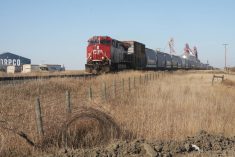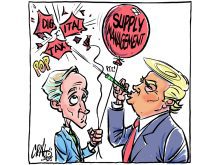Energy sources
I’ve received several calls and inquiries concerning the letter I wrote in the April 20 issue of the Western Producer, under the heading “Growling stomachs.”
Most persons were concerned about the statement I made that producing food to feed the world’s population and developing new sources of fuels and energy are “ultimately one and the same.”
No, I did not suggest that we pour crude oil on our porridge in the morning. The point that I was trying to get across is that food, oil, uranium, and crude oil are ultimately one and the same. They are all sources of energy. …
Read Also

Agriculture needs to prepare for government spending cuts
As government makes necessary cuts to spending, what can be reduced or restructured in the budgets for agriculture?
A good portion of the crude oil and other sources of energy we produce are wasted. Fuel guzzling recreational vehicles, unnecessary travel, inefficient buildings, appliances and lighting, and a general disregard for environmental concerns on behalf of the North American population are but a few of the causes of rising fuel costs.
Subsequently, when the demand for crude oil soars, so does diesel fuel, fertilizer and other farm products that require oil and natural gas for the manufacturing process.
Sadly, grain, oilseeds, beef and other farm products rarely follow fuel and other farming and ranching expenses.
In order for food prices to follow rising energy costs, we need to get rid of archaic methods and beliefs. For example, why are wheat and durum being sold by the bushel or the tonne, and not according to the food and heat energy they contain?
I guess if I had the answer to that problem, I’d be floating around the Cayman Islands in a yacht powered by twin diesel engines, and guzzling margaritas, and 20 gallons of diesel an hour.
After all, it is my constitutional right to waste energy, isn’t it?
– John Hamon,
Gravelbourg, Sask.
Sold down river?
On the 27th of April, the Canadian government announced with great fanfare that Canada and the United States had at long last resolved the softwood lumber dispute. A new seven-year agreement has been eventually negotiated, one that addressed all of our major concerns.
The national media reported the story almost exactly as the government would have wished, heralding it as a triumph for the new Conservative administration.
An examination of the agreement itself, however, may lead us to question this rosy picture.
The U.S. wanted to restrict the amount of lumber that Canada could sell them. This agreement does so. …
The U.S. had illegally extorted $5 billion from the Canadian industry. Under this agreement only four fifths of that money will be returned.
Canada wanted free access to the U.S. market as guaranteed under the North American Free Trade Agreement. We didn’t get that. We wanted to ensure that our industry could compete on a level playing field. We didn’t get that either. We wanted the U.S. to return all of the money illegally taken from Canadian producers, and that didn’t happen.
We have an agreement that gives the U.S. everything it wanted and gives Canadians nothing. A triumph indeed.
Why am I writing about a softwood lumber agreement in a western farm newspaper? I do so because it clearly illustrates the risks that we face as Canadian producers. We are currently involved in formal and informal, bilateral and multilateral negotiations that include agriculture.
The U.S. quite naturally wants to enhance its competitive position in the world market for agriculture products. To do this it wants to do away with the Canadian Wheat Board. It wants to eliminate orderly marketing for poultry and dairy products. It has concerns about the competitive advantage that the Canadian Grain Commission gives us. It wants to control what we do with regard to the registration and patent protection.
The U.S. will undoubtedly pursue its objectives with great vigour and determination. Who will represent our interests as Canadian farmers? If the lumber agreement is any indication, no one.
The same people who brought the “no free trade” NAFTA agreement have now delivered the giveaway softwood lumber deal. These are the folks that say they will defend our interests as farmers.
Let’s not allow the purveyors of snake oil and fairy dust to sell us down the river as well. Let’s for once stand together and demand that we not trade away institutions and policies that enhance our ability to compete for the illusion of “free trade” and “market access.”
– Gerard Hoppe,
Cando, Sask.
Bogus beef
It is hard not to notice all of the high fives going around at Alberta Beef Producers/Canadian Cattlemen’s Association offices these days. We seem to have this BSE thing licked and business is back to normal?
I think not. In fact, I think that, just as the packers of this country have found new ways to do business off the backs of producers, ABP/CCA has found a deceitful way to con the consumer of this country while letting this salmon run of profits roll on in the cull cow market.
We sit back and watch the top cuts of beef roll across the border to the United States, now even more that the border is open to live cattle and not just those precious boxes. And we watch the cull cow meat served at every restaurant and retail market in this country that is low enough to use the “take advantage of the situation” tactics that every packer in this country has used for the past three years.
So where is the deceit at the ABP/CCA level? Simply support for these ridiculous notions that use producer dollars to promote and set that cow beef in front of the consumer rather than our top youthful cuts – support that may help the producer get half of what he used to get for his cull cow, while fetching insane profits from this same beef for the packer and the retailer, and truly deceiving the consumer.
We will be lucky if we retain any steak sandwich customers if we keep this up much longer….
If BSE testing would have been allowed from the very beginning, supply and demand could have worked its magic. Instead we live in a cull cow market controlled by those who oppose this free marketing of beef and love the profits that control gives them.
I imagine I will be corrected for my misconceptions once again by the chairman of one of these groups who stand no opposition in this country.
– Randy Kaiser,
Ponoka, Alta.
Good neighbours
I just read a letter by Gerrid Gust in the April 6 Open Forum titled “Close call” and it gave me cause to think of my own situation and how careful I must be.
Due to the economics of farming these last two years, my husband needed/wanted to go back to the oil patch to work ….
He is about four hours away from home but is only home on his days off. So this has left me very much alone at home to tend and feed cows, calves and horses.
Safety is the utmost important thought in my mind at all times. I feed with a tractor and front-end loader. I never walk under or near the loader when suspended in the air. I take a wide berth around the tines and bale spear on the front of the bucket ….
Even one slip of the foot when getting in or out of the tractor could end up with my head being smacked on the loader frame or the steps and me lying there unconscious or whatever.
And due to the fact that cell phone coverage in our area is patchy at best, I do not carry one.
But I do want to share with you my safety line. We have the most wonderful, caring neighbours of anywhere we’ve lived. When they knew that my husband was going to have to be away from home to work, they insisted I had to call them every day as soon as I got in from finishing chores.
If I did not call in by lunch, they would be on their way over to our place right away to check on me in case of any problems.
What comfort and peace of mind this has given my husband knowing that they are looking out for me and my safety.
There is no thank you big enough to show our appreciation for them and the other neighbours who have helped me with loader problems and calf problems. The true essence of the good neighbour policy is most certainly alive and flourishing in our area.
Let us all take that one extra moment that might be needed to think about how to keep ourselves and others safe when we go about our duties, chores and repairs every day on the farm or ranch.
– Rae Huber,
Montmartre, Sask.
MMT trade
It is extremely unfortunate that despite numerous attempts to clarify what has happened in regard to MMT in Canada, there is still a great deal of work to be done.
This has become painfully obvious based on the statement in David Orchard’s letter of May 4 (Another colour).
Specifically statements that link the Ethyl MMT case to environmental laws are wrong and extremely unfair to both the government and to Afton (new name for Ethyl Corporation) in the government’s actions in reference to our product MMT.
The government’s history with our product, the fuel additive MMT, is not an example of what can go wrong with international trade.
The simple fact of that matter is that there would not have been a NAFTA issue if the legislation which attempted to ban the importation and interprovincial trade of MMT in Canada had been based on scientific evidence.
The legislation did not ban the use of MMT in Canada; it banned its trade, as it has been proven in test after test that MMT does not harm the environment and does not constitute a health risk to Canadians.
Bill C-29, the legislation in question, was a trade bill – it was not an environmental bill.
And the fact that it was a trade bill without scientific proof led to the NAFTA action.
To its credit the federal government admitted that in settling the matter before it went to a hearing.
– C.S. Warren Huang, PhD,
President,
Afton Chemical Corporation,
Richmond, Virginia
















